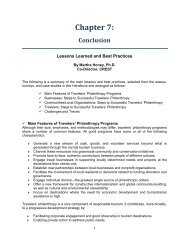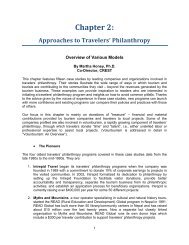Travelers' Philanthropy Handbook - Center for Responsible Travel
Travelers' Philanthropy Handbook - Center for Responsible Travel
Travelers' Philanthropy Handbook - Center for Responsible Travel
You also want an ePaper? Increase the reach of your titles
YUMPU automatically turns print PDFs into web optimized ePapers that Google loves.
• Timing: Do you intend to operate in the area <strong>for</strong> the long haul?• How well do you know the community? Speak their language? Understand their way oflife, priorities, strengths, and challenges?• How effective is this initiative likely to be? What are the risks?• Will the project be managed from inside or outside the community?• How can your project avoid creating dependency? If you discontinue operating in theregion, does the project have other means of support so it will be able to continue?• Will the project hold up to external scrutiny and demonstrate accountability?• What are the local cultural and religious beliefs and practices around charity and giftgiving?• How will you avoid scams and corrupt practices which may be common but not obviousto an outsider?Since your primary role is operating or working <strong>for</strong> a travel business, generally it is not advisableto create and manage a local project yourself. Your travelers’ philanthropy program is muchmore likely to be effective and sustainable if your company can bring resources to a local NGOthat has expertise in the issue you seek to address, has a deep cultural understanding, andalready has solutions to problems. In addition, a local NGO is more likely to be operating in theregion over the long-term. However, in some cases, particularly in remote regions, local NGOsmay not exist and your company may decide to initiate a local project. Take this route only ifyou can allocate dedicated staff towards managing the project and ensuring its success. Therecommended steps, listed below, <strong>for</strong> developing a successful project will help you analyzewhether you can commit the necessary time and resources.• Step 4: Identify and Consult Stakeholders; Learn About Their Decision-Makingand Governance Practices.Who are the stakeholders in the community in which you hope to work? List them all andidentify the linkages and hierarchies and varying degrees of vested interest. It can be useful tomap stakeholders and their relationships using mapping tools or graphics. For example, makecircles of like-minded groupings, illustrating overlaps of commonalities. There will be electedleaders, relevant officials within different levels of government, and other leaders who deriveauthority from traditional or ethnic power relationships, economic power, religious power, etc.There will be groups of people with different agendas or reasons <strong>for</strong> buying in to your project.And there will be those on the fringe or outside of the community with a less obviousinvolvement, but who will be impacted.Consult ALL stakeholders, in a number of <strong>for</strong>ums, and over time. There should be widerepresentation and culturally appropriate opportunities <strong>for</strong> all voices to contribute and be heard.It may, <strong>for</strong> example, be useful to consult with the women independently of the men, particularlyin a patriarchal society, or to consult with members of “civil society” separately fromgovernment-appointed authorities. Take note of not only the voices you are hearing, but alsothose you are not. Work to provide opportunities <strong>for</strong> the latter group to participate in a different<strong>for</strong>um.• Step 5: Set Objectives and Parameters <strong>for</strong> Your ProjectDecide and clearly articulate what you wish to achieve and set a realistic time frame. It's greatto have ambitious goals and high ideals, but it is sensible to set some smaller achievable steps<strong>for</strong> the first year of support. Establishing interim objectives will give you the opportunity to refine118















